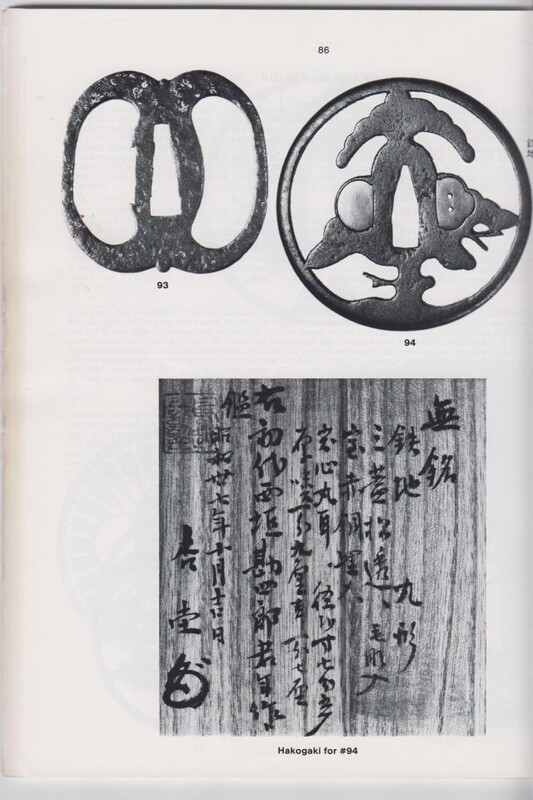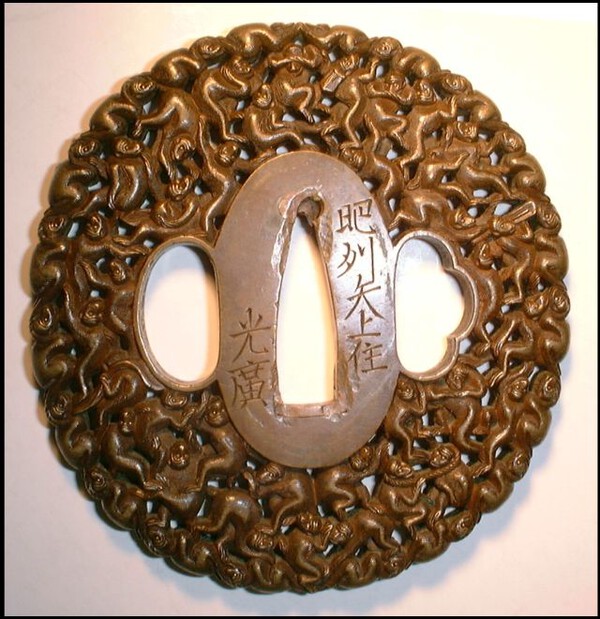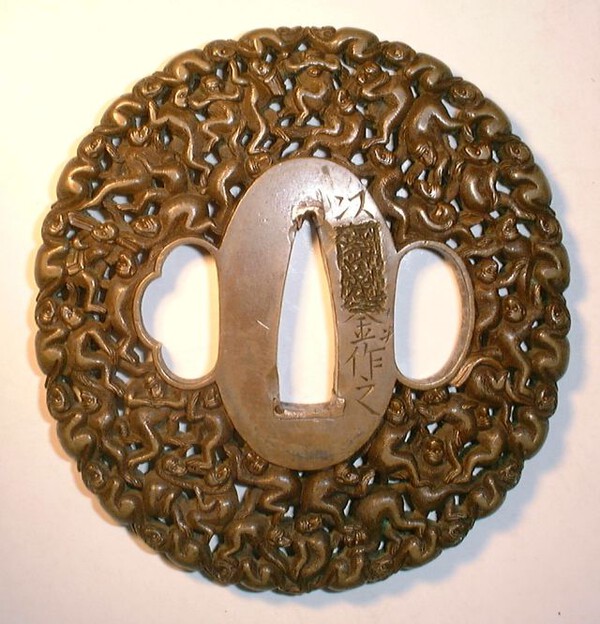-
Posts
815 -
Joined
-
Last visited
-
Days Won
2
Content Type
Profiles
Forums
Events
Store
Downloads
Gallery
Everything posted by docliss
-
Ford, I must of course agree with you that a large number of Namban tsuba are cast, especially the later Japanese examples. But 'fakes'? John L.
-
Ford, as far as I am aware there has been no suggestion that 'the majority of Namban tsuba were not made in Japan'. Indeed, they were, particularly after the beginning of the 19th century. John L.
-
Dear Ford, to repeat an earlier posting: viewtopic.php?f=2&t=5513&st=0&sk=t&sd=a John L.
-
While acknowledging that Dale's tsuba, featuring a Portuguese trader, with its decorative seppa-dai, its karakusa motif and its decorative mimi, demonstrates a namban influence it does, in my opinion, lack the defining characteristics of the Namban group. Its crude and unskilled character, with its clumsy gilding, also make it quite unsuitable as a presentation piece although, with its elaborate seppa-dai, virginal and unnecessarily large nakago-hitsu and the inappropriate placing of the kozuka-hitsu, it was probably never intended for mounting. This tsuba was probably a shiiremono, made in the Nagasaki docks in the late 19th century solely for export. I am labelling the figure a Portuguese trader since I do not believe that the exposed base metal on the face, hands and feet, nor the unskilled facial features, are indications of an African nationality. The significance of the gumbai as an badge of rank on such a figure I do not understand; perhaps John can help. While I agree with Ford's reticence over the importation of tsuba into Japan, I believe there to be two examples where this may have occurred. 'Those tsuba that are today called Namban appear to have been produced in China or by the Dutch East India Company in India and imported from the end of thee 16th century.' (Ogawa (1987), Japanese Swords and Sword Furniture in the Museum of Fine Arts, Boston, no 353, pp 353 and 353). Additionally, those Namban tsuba labelled as belonging to the Auriculate sub-group, and bearing the VOC logo of the Dutch East India Company, may well have been manufactured outside Japan and imported during the Momoyama period. (Syz (1994), Masterpieces from the Randolph B. Caldwell Collection, no 34, pp 50 and 51). To what extent such imports were commercial or were the result of purchase by individual, travelling Japanese is clearly unknown. John L.
-
Keith, as requested, please see attached image of a Kanshiro tsuba taken from Haynes' Catalogue #7, p.86. John L.
-
I have enjoyed this instructive thread, and it is enlightening to compare this with the manner in which a similar subject, posted by Grey Doffin on 26 August 2012, was discussed at that time. I note that no observations have been made upon the frequency of sayadome-ana that appear as a pair of small perforations in the kōgai sekigane of a tsuba. The small size of these suggests that wire, rather than a twisted paper tie, was used to affix the tsuba to the kurikata. viewtopic.php?f=2&t=13723&p=118579#p118579 John L.
-
This interesting mei reads FUNADA IKKIN YOSHINAGA with kao, and this mei and kao are, surely, those of Funada Ikkin I. John L.
-
Would the owner please post images of this tsuba after the cleaning process? It is an interesting tsuba, and well worth the effort. With thanks, John L.
-
Thank you Brian for your PM. Quite a surprise to see the very similar tsuba on ebay, although there are very slight variations in the tagane-ato around the nakago-hitsu, and the iron quality is quite different. In view of the large number of Aizu Shōami workers, and their reputation as copyists, the existence of similar tsuba is not surprising. Judging from the quality of the plates, I believe that the ebay tsuba is the earlier one and yours a later copy. I do not accept any possible suggestion that these are cast copies. Kind regards, John L.
-
Brian, Iron nagamaru gata it certainly is, to state the obvious. 19th (or late 18th) century it probably is. But Ko-Nara …? This latter group includes the work of the first four Nara masters, their students and co-workers, and is thus dated prior to the end of the 17th century. No way is your tsuba as early as this; neither is the iron nor the work appropriate for this group, With its broad ryō-hitsu, my tentative attribution would be late 18th or early 19th century Aizu Shōami work. Kind regards, John L.
-
No, they ere not papered Justin. Regards, John L.
-
I have been hors de combat for several weeks but am now able, rather belatedly, to post images of a pair of fuchi-gashira that are very similar to Justin’s orphaned fuchi #2. Rather than a mei and seal on the koshi, this fuchi bears a nijimei on the tenjō, which has vertical yasurime – a kantei feature of Joi fuchi. John L.
-
Dear Elliott, where do you get your ‘ca 1500’ from? To me, your tsuba is very reminiscent of Fujiwara Kunishige ( H 036549.0), or Fujiwara Kunimichi (H 03613.0) work. Both of these artists were working ca 1700-1800. John L.
-
I share Peter’s enthusiasm for tsuba #1, although it is rather sadly abraded. But I would certainly classify it as Hizen work, with a design based upon the mythological and grotesque creatures that featured on Portuguese tooled and worked leather. This was introduced into Japan in the seventeenth century. This tsuba features extensive nunome-zōgan – a characteristic of Hizen work – and I presume, by its exclusive use of silver nunome, that it predates the multicoloured example illustrated on pp.46-7 of Grahan Gemmel's Tosogu: Treasures of the Samurai. This he dates as mid-eighteenth century. John L.
-
I agree with Christian that Grev’s last tsuba is certainbly not Hirata work of any age. I had supposed it to be late work by Aizu artists, or produced for export at the docks at Yokohama. But Christian’s suggestion of Somada Mitsumasa intrigues me. Is he suggesting that this is, in fact, not shippō but is rather lacquer, or that S. Mitsumasa did actually produce some shippō work? If the latter, I was not aware of this. John L.
-
Do the images that K Morita has posted have any indication as to which of the three Mitsuhiro artists they can be attributed? That would be really great .... John L.
-
-
I will, if I may, follow Clive’s posting with a second example of Noda Mitsuhiro work. This is another of the ‘thousand monkeys’ theme, the animals depicted in very fine katachi-bori, with kebori detail and with gold inlaid eyes. Careful inspection of the images reveals the three sambu-naru monkeys that could not see, speak nor hear any evil, and a pair playing the game of strength known as kubi-kubi. The tsuba is inscribed on the omote HISHU YAGAMI (NO)JU MITSUHIRO, and on the ura MOTTE (WO) XXXX KANE KORE (WO) SAKU Part of this latter inscription has been defaced: a similar tsuba, illustrated on pp.544-5 of Tsuba Daikwan, is inscribed on the reverse ‘Sentokū Kane (wo) Motte Saku Kore (wo)’. Sentokū was a valuable alloy, the use of which was, at one time, confined to coinage, and this may be the explanation for this erasure. Ex Radford Ex Peak Ex Hawhshaw collections. There were three artists of the Noda family who signed their work thus. Mitsuhiro II was the younger brother, and Mitsuhiro III the eldest son, of the first master. The repetitive nature of the animals depicted in the mimi, and the curvature to the left of the second and third vertical strokes of the ‘shu’ kanji suggest that this tsuba is by N. Mitsuhiro I (ca 1750-1800). John L.
-
Dear Marcos Welcome to the NMB, and I look forwards greatly to many exchanges of information on your specialst subject. By the way. you should sign all of your posts with your name, as per the NMB rules. Kind regards, John L.
-
Here is another example of a cup-shaped tsuba. Of a darkly patinated iron, and octagonal in shape, it is bordered by a double, raised rim. Both surfaces are covered by a low relief design of flowers and vegetation, this being more profuse on the omote (convex) side. The base metal has a fine ishime surface, and there are remnants of gold decoration on the design. This was once covered in its entirety by a gold nunome overlay, and would have been very striking in its appearance. The floral design is possibly derived from 17th century, Portuguese tooled and worked leather. This is an example not of a Namban tsuba, but of 18th century Hizen work, which commonly features extensive nunome decoration. John L.
-
David, I have already discussed your first tsuba in some detail in a previous thread. I believe – and correct me if I am wrong – that it demonstrated all of the defining characteristics of the Namban group of tsuba; that the large, circular apertures may once have contained decorative inserts; and that it probably dates from the Momoyama period. It may, indeed, be a scarce example of an early, imported tsuba of this group. I had hoped that the shinsa panel would have at least suggested a jidai for your money! Your second tsuba is not Namban, but might be considered to demonstrate a namban influence. Jean, I prefer to label cup-shaped tsuba such as yours not as Namban, but rather as from their school of manufacture – ?Chōshū, ?Bushū, ?Hizen … – and demonstrating a European influence. John, contrary to what one might expect, those later reproductions produced by Japanese artists in the late 18th and early 19th centuries demonstrate a higher standard of workmanship than do the earlier, imported examples. This is doubtless due to the better metalworking techniques available to the later artists. I am unable to make any comparison of the quality of the iron of these two groups. The extensive sukashi work on these tsuba makes impossible any attempt to judge the quality of the iron, and I know of no modern, non-destructive, physical analysis of this. John L.
-
‘Those tsuba that are today called Namban (literally ‘southern barbarian’) appear to have been produced in China or by the Dutch East India Company in India and imported from the end of the 16th century. The category also includes reproductions of these imported pieces later made in Japan’. Ogawa (1987). John L.
-
Thank you Chris - my very first signed Namban tsuba! John L.
-
I fear that I must take issue with the above statement by Jean, which appears to attribute all Namban tsuba to the province of Hizen. If one accepts Ford’s premise that the label ‘Namban’ represents a style rather than a school, then the temptation to attribute this group of tsuba to a finite location is greatly diminished. I have no doubt that, in the early days of this style, the main location for their manufacture was, indeed, the immediate environs of Nagasaki. But by the late 18th and early 19th centuries the popularity of these tsuba was universal, to the extent that 'they suddenly overwhelmed a generation' [Homma and Satō, 1935-36], and it is likely that many of the existing schools throughout Japan had adopted Namban traits. John L.










